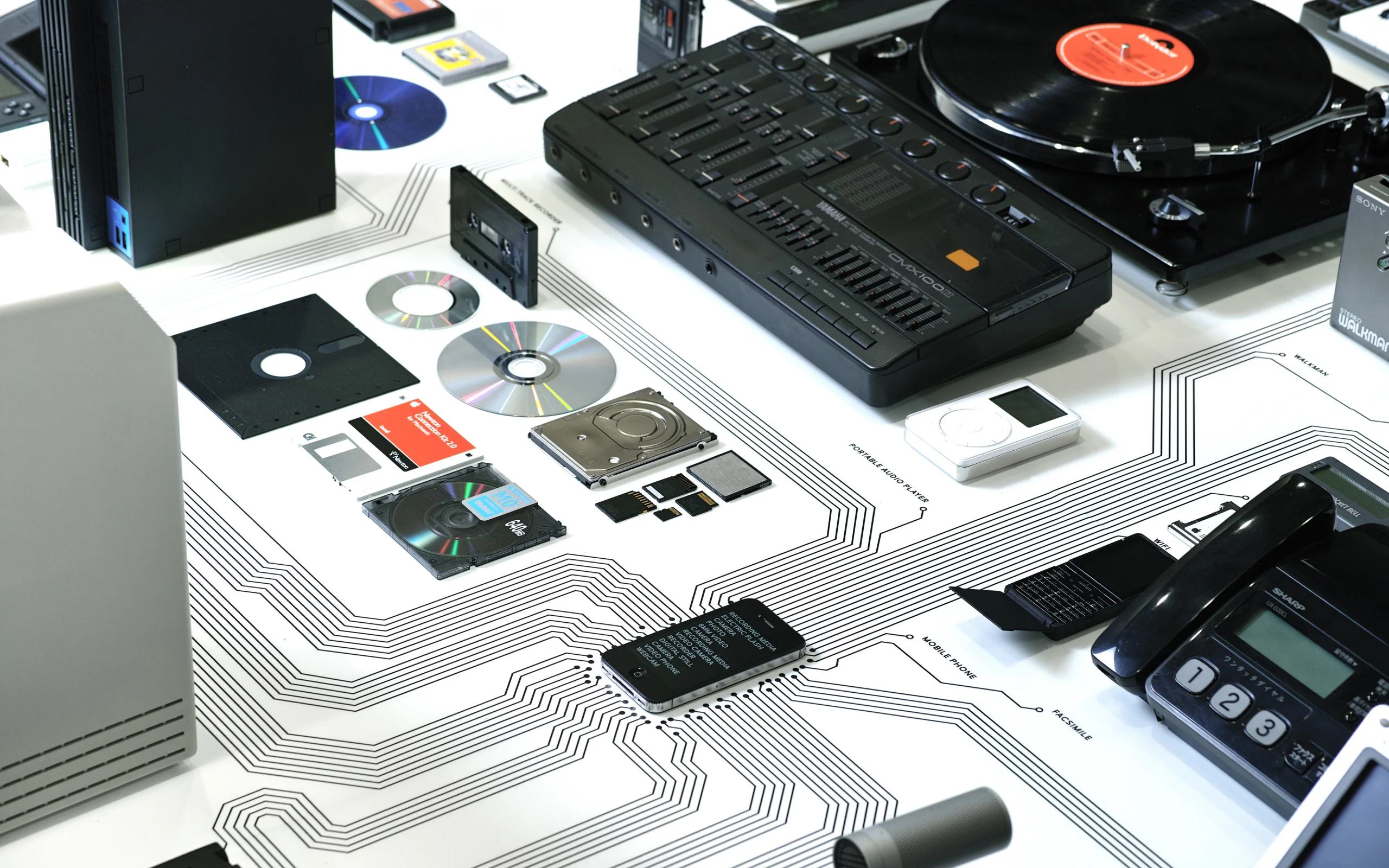
PROJECT
ggg/ Integration
iPhoneの機能に融合された旧来の道具を並べ、「融合」という創造の基本思考を視覚化した展示。

WHY
イノベーションを
生むための基本とは。
社会は急激に変わっています。成長の限界と言われた1972年から50年が経った今でも、我々人類はまだ成長し続けています。生物多様性の崩壊を食い止めるための変化や持続可能な社会を保つためのアクションは、もう時間的な猶予が全く残されていない状況と言っていいでしょう。社会を変える人がもっとたくさん必要だと、心から感じます。どうすれば、そのような人を増やせるのでしょうか。そういえば私達は、物が社会を変えることを「進化する」とよく言っています。社会を変えることが進化だと言うなら、私達はもっと生物の進化から社会の進化を生むためのプロセスを学ぶことができるのではないでしょうか。

HOW
創造ではあらゆるものが
交配し融合する。

人工物のデザインにおいても、技術の進歩、人の趣向性や時代のコンテクストの変容によって、モノは絶えず進化と淘汰を繰り返しています。多様性を前提とした種の発達は、生物の進化の形によく似ています。常に発明は人の進化を補おうとしているようにも感じられます。より速く、より楽に、そんな哲学によって進められてきたデザインは、進化しようとする人類の本能ではないでしょうか。もし生物の進化とデザインが充分に似ているなら、そのプロセスをよく理解し、発明やデザインに応用することでイノベーションを起こしやすくなるはず。進化思考は、そのような考え方から生まれた、自然から学ぶ新しい創造教育のための手法です。

融合して, 共生する。
生物は融合して進化する。単細胞生物が 動物の細胞に進化していく過程で、他の生物だったミトコンドリアを取り込んだのは、まさに代表的な例だろう。他にも、藻からクロロフィルを取り込んだ ウミウシが光合成できるように進化する など、他者の機能を取り込んで拡張する融合のプロセスは、進化のための基本法則の一つと言える。
人工と自然の間にある融合の例では、遺伝子操作が挙げられる。蜘蛛の 遺伝子を植えこむことによって、蜘蛛の糸と同質の糸をつくることのできる大腸菌を生み出すなど、人はDNAの謎を解いて新しい機能を融合した生物を作るに至っている。しかし、DNAをハックされた新しい種が環境にどのような影響を及ぼすかという視点では、未来は全くの 未知である。
人工物のデザインやイノベーションに とって、融合は欠かせない方法だ。 かつてヨーゼフ・シュンペーターが、イノベーションという言葉を「新結合」と定義したように、人工物の発明では、別々のものを融合させることが新しいモノを 生み出すための基本である。

積分回路。
いつの間にか私たちが使う携帯電話には、無線・カメラ・コンピューター・方位磁針・GPS・メモ・ゲーム機など、無数の道具が融合している。破壊的イノベーションと言われるとおり、融合が進むと同時に、これらの道具の市場は携帯電話に飲み込まれているとも言えるだろう。ここでは、それらの道具たちを一つ一つ 集め、融合を観察した。その全体像から 見えてくるのは、人がどんな進化を 望んでいるかという欲望の形であり、隙間に見えてくるのは未来の進化の余地でもある。

WILL
あらゆる発想法を
統合する
進化思考の誕生。
小さな実験的展示から始まった進化思考は、いま日本最大級の規模の自動車会社・不動産会社やアパレルのグローバル企業の経営者など、徐々に賛同者に応援されながら広がりつつあります。(参考記事:
INFORMATION
- What
- ggg/Integration
- When
- 2016
- Where
- Tokyo, Japan
- Client
- Scope
- Installation / Space Design
CREDIT
- Artwork
- NOSIGNER (Eisuke Tachikawa)
- Photo
- Kunihiko Sato









